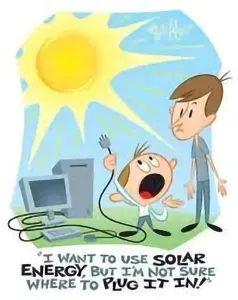If you were to develop a ranking of some of the hottest debates in modern times, renewable vs. non-renewable sources would probably come out on top. And that is still despite almost everyone knowing that renewable energy is the better alternative.

Solar energy pros and cons have been at the center of this debate for as long as it’s existed. Eco-scientists see solar power as the future of energy alternatives, governments endorse it (albeit a little bit), and some corporations have started large-scale harnessing of solar power. This has made it one of the fastest-growing renewable sources of energy on the planet.
But how does it compare to other sources of energy? This article will compare solar energy to other renewable and non-renewable sources, including fossil fuels, hydroelectric power, wind energy, geothermal energy, nuclear energy, and biomass.
Table of Contents
- Types of Energy Sources (Power and harnessing)
- Costs of alternative power sources
- Solar Adoption rate
- Solar Efficiency (average capacity factor)
- Usable life
- Impact on the environment
- So, where does solar energy stand?
Types of Energy Sources (Power and harnessing)

Solar energy comes from our nearest star, the sun, which sends us enough power in an hour to power our world for a year. Humanity uses this energy to heat homes, heat water, cook, and power home appliances, but will often require the solar power to be converted into a usable form first.
This conversion is usually done using a solar panel system. Solar panels consist of numerous photovoltaic (PV) cells that convert photons into electricity. This electricity is either used by appliances immediately and (or) stored in batteries for later use.
Concentrated solar power stations were viewed as a better way to harness large quantities of solar power for a while, but they’ve fallen out of favor due to their low efficiency and high environmental liability.
The best renewable energy source for the future might be quantum dot solar cells. These small PV dots can be integrated into windows and possibly personal devices to provide efficient electricity.

Fossil fuels were formed by a natural process occurring over hundreds of millions of years. Little plants and animals living on the earth’s surface died, and as the eons unfolded, their remains were slowly covered by increasingly thick layers of earth. The resulting high temperatures and immense pressure converted their decomposing remains into what we now know as fossil fuels; coal, oil & petroleum, and natural gas.
We have to drill miles underground to get to fossil fuels as they’re usually buried deep. Once obtained, burning them breaks down the atom bonds storing the energy, releasing it for use.
Read More: What Are Some Alternatives to Fossil Fuels? Here are the most promising alternatives to fossil fuels for transportation.

Wind power is another readily available renewable energy source. It uses the wind’s kinetic energy to turn the blades of wind turbines, which then turn an electric generator via a drive shaft, generating electricity. Windmills are some of the earliest forms of harnessing wind power.
There are some wind energy pros and cons. One negative is that turbines are expensive to install but a positive is that they harness one of our ultimate renewable energy sources.
Hydropower is the most widely used renewable source of energy. It is created when rapidly flowing water turns turbines, generating electricity. This usually happens in a hydroelectric facility, consisting of a massive dam that converts the potential energy of water in the reservoir to the kinetic energy necessary to turn a turbine.
Geothermal energy is harnessed by directing the steam from superheated water into power generation turbines. The steam spins the turbines which convert the energy into electricity.
3 of the main advantages of geothermal energy is that the energy produced is clean, consistent, and renewable.
Nuclear energy is stored in the nucleus or core of an atom. This energy is released from the atom in the process of nuclear fusion; the atoms are split to release the energy needed to produce electricity. This process takes place in nuclear reactors or power plants, where the atoms of uranium are split. See our related article showing the Pros and Cons of Nuclear Energy
One of the huge advantages of nuclear power as alternative energy is that it’s a cleaner source of energy than any type of fossil fuel, biomass, or even solar, it isn’t renewable so we can’t rely on it forever.
Biomass or biofuels produce energy from organic matter like human and animal waste, food waste, wood, and crops waste. These release energy when burned in their physical form (like wood) or after undergoing certain chemical processes that convert them to combustible gas. See our related article on the major Pros & Cons of Biomass Energy.
Costs of alternative power sources

Solar electricity is often presented as a long-term cost-saving alternative for households and businesses. And while this is true (households can save an average of $78,000 in reduced electricity bills over their panel’s lifespan), the startup costs are quite high for the consumer.
For example, the average cost of initial installation of a solar energy system in the U.S is $12,000 to $15,000 after state incentives. The good news is this cost has been declining over the past decade, with this trend is expected to continue over coming years.
One of the major costs of solar is the battery bank to store the energy for later use. One of the benefits of battery recycling is that the materials recovered from old batteries are just as good as new.
So, new batteries can be made with recycled materials at a much lower cost than those made with virgin materials. This will help the cost decrease over time.
In all other energy sources, except biomass, the consumer doesn’t incur startup and installation costs. This is because energy is harnessed at a much larger scale than any one person can consume in their lifetime, and the startup costs are extremely high, numbering in their hundreds of millions of dollars.
Thus, we have to use smaller units of energy, the kilowatt-hour, to compare their costs to that of solar energy.
That said, solar energy costs an average of 3-6 cents per kilowatt-hour, but it’s practically free for those with a solar energy system installed. On the other hand, generating a kilowatt-hour of electricity from fossil fuels costs between 5 cents and 17 cents.
Nuclear energy costs 9 cents, wind energy 5-6 cents, and hydroelectric energy is the cheapest, at around 1 cent per kilowatt-hour.
Solar Adoption rate

In 2019, there were over 2 million solar installations in the United States, providing enough energy to cater to the needs of around 16 million households in the country. These numbers seem small when compared to the sheer scale of the US. However, they represent a significant growth in solar adoption and show an encouraging trend that could see solar energy account for half of all renewable energy in the next decades. It is estimated that by 2024, there will be well over 4 million solar installations all over the country.
Still, fossil fuels remain the largest energy source in the country. They are used to power machinery in industries, cars, buses, and airplanes and provide most of its electric power supply. This widespread use is because fossil fuels are super convenient as much of humanity’s technology has evolved and adapted to them. For instance, look at vehicle and jet engines; much of their development took place with fossil fuels in mind.
Fossil fuels are also pretty cost-efficient. The cost of mining and power generation may be high, but the industry enjoys incentives and subsidies from world governments that make it cheaper to use.
Hydropower accounts for about 6% of electric power consumption in the US and nuclear energy around 19.3%.
Solar Efficiency (average capacity factor)
The average capacity factor of an energy source represents the ratio of the actual amount of electricity generated compared to the maximum amount that an energy source could potentially generate.
Currently, solar panels convert 15% to 20% of the sunlight they receive into electricity. It’s obviously not the most efficient of energy sources, but that rate is still good enough to generate enough power to supplement a home’s daily electricity consumption. It’s even more impressive when you consider that the first PV cell only converted 4% of the sunlight into energy.
As increasingly more funds are poured into research and development, solar technology keeps getting better. Today, the highest recorded average capacity factor of solar PV cells stands at 40%. This was achieved using technology that allows solar cells to capture different frequencies of light on the electromagnetic spectrum.
Unfortunately, these solar cells are yet to be available to the general public. The technology is still in its infancy, and the costs of production are quite high. Dont fret though; over the coming decade, production will be sustainable enough to launch such solar panels in the market.
Something important to note is that solar panel efficiency drops over time. The sun will be as strong 25 years from now as it is today, but the PV cells on your solar panel would have degraded to around 75% of their current efficiency. Most manufacturers guarantee 90% of their panel’s efficiency after the first ten years and around 80% after the next ten years. So, after 25 years, a solar panel is considered at the end of its useful life, and it’s usually time to get a new one.
On the other hand, fossil fuels are quite efficient, averaging 35% for coal, 38% for petroleum, and 45% for natural gas power generation. This partly explains why they’re so hard to quit for many people and industries around the world.
Today, Wind turbines average about 30-35% efficiency and can rise to 50% efficiency at peak wind speeds. This is a significant improvement from the 25% efficiency of wind energy projects installed at the beginning of the century.
Hydropower plants convert around 42% of the water’s kinetic energy into electric energy.
Biomass is also has a relatively high average capacity factor, with wood burning at 58.4% efficiency and other biofuels enjoying rates as high as 64 %.
Nuclear plants are currently the most efficient source of electric energy, operating at a capacity factor of around 93%.
Usable life
Solar panels have a usable life of between 25-30 years. They don’t automatically stop generating electricity after 30 years, but rather, their output is greatly reduced that it’s no longer worth the effort. Fortunately, you can always buy a new panel since the sun has 5 billion years to go before it expires.
The same can’t be said about fossil fuels, which usually last as long as the flame burns. So, while it took millions of years to form ten grams of coal, it takes bout 10 seconds to burn through it. This means we’re bound to run out of fossil fuels sooner rather than later.
On the other hand, the average lifespan of a hydropower plant is 100 years. But we can always build more facilities or upgrade existing ones to extend their usable life. Hydroelectric power is also renewable and will be available for harnessing for as long as the rivers run.
Most nuclear plants have operating life spans of 20 to 40 years before they deteriorate with age and get decommissioned and demolished. If 20 years seems too short, then you’ll be glad to know that engineers are designing newer plants with 40 to 60 years worth of operating life. Refurbishment may also help extend the life of existing nuclear power plants.
It’s also important to note that we won’t have nuclear energy forever. Experts estimate that using our current uranium consumption, we only have enough uranium to last the world for the next 80 years.
Impact on the environment
Given the current state of our planet and its atmosphere, almost all energy discussions culminate on the sources’ impact on the environment. What are the said energy source’s effects on the earth? This question is largely responsible for humanity’s desire to switch to solar and other renewable energy sources.
See our related article where we look at 17 Major Environmental Issues. See how they affect us and our future.
Solar energy has virtually no impact on the earth; it doesn’t emit greenhouse gases or cause significant pollution to the environment. Most importantly, solar energy’s supply is infinite. We still have around 5 billion years worth of it, shining on us every day at a much larger scale than we’ll probably ever be able to consume.
There is damage caused during the manufacturing and transportation of solar panels, but it’s on a scale too small to warrant concerns.
On the other hand, fossil fuels are pretty much responsible for the pollution and climate change crisis currently facing our planet. Burning fossil fuels releases carbon dioxide and other greenhouse gases into the atmosphere, something we’ve been doing for a couple hundreds of years. The result is global warming on a scale that is disrupting the earth’s delicate ecosystem and moving life on our planet a step closer to extinction.
Hydroelectric power may be renewable and emit zero greenhouse gases, but the effects of creating dams have had devastating consequences on river ecosystems. Fish migration patterns have been blocked, and thousands of animal species displaced as their natural habitats became flooded with water from reservoirs.
Nuclear energy is also quite clean (no greenhouse gases released), but it also creates radioactive waste that is pretty lethal to the environment. Accidents have also occurred, contaminating entire towns and resulting in loss of life and the evacuations of thousands of families from their homes.
Last but not least is wind energy, which is just as clean and renewable as solar.
So, where does solar energy stand?
I’d say on pretty solid ground. Compared to fossil fuels and other renewables (excluding hydropower), solar energy is better poised to usher us into an era of clean, sustainable energy. This is because we practically have an infinite supply of it. The technology is also getting better and cheaper with time, and most crucial, it has almost zero negative impacts on the environment.
